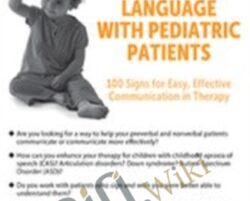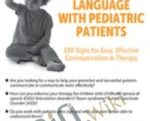In this recording, you will learn to recognize and demonstrate 100 signs and incorporate them into your practice right away.Sign language isn’t only used by the Deaf community; it is often used by children with general speech and language delays and disorders, developmental delays, childhood apraxia of speech (CAS), autism spectrum disorder, Down syndrome, and hearing loss. One effective way to communicate with this population is through sign language. However, many don’t have time to become fluent in American Sign Language (ASL). Course instructor, Jill Eversmann, is here to help! In this recording, you will learn to recognize and demonstrate 100 basic signs, the manual alphabet, and numbers from 1-20 as well as how to incorporate them into your practice immediately.Recognize and demonstrate 100 basic ASL signs, the manual alphabet, and numbers 1-20Explain how and when to begin using sign language with a patientRecognize the benefits of sign language for children with Down syndrome, autism, childhood apraxia of speech, and general speech and language delays and disordersDistinguish the use of sign language in preverbal and nonverbal hearing patientsExplore the benefits of using ASL as an AAC system for preverbal and nonverbal hearing patientsEvaluate the factors to consider when determining whether or not signing is a good communication option for a patientKEYS FOR SIGNING SUCCESSBrief history of ASLBasic rules for producing signsBenefits of signing25 signsManual alphabetSigning vs. spellingProper names, initialized signs, describing sign formationLABASL using songsDemonstration (video)Interactive sign reviewInteractive review of the manual alphabetSpelling skillsKEYS TO SIGNING IN EARLY INTERVENTION25 signsNumbers 1-10How and when to startIndicators and contraindicationsSigning with young childrenGreetings, eye contact, and attention skillsSupplement speech and language skillsReduce the frequency of tantrumsKEYS TO SUCCESS FOR THERAPISTS, HEALTHCARE PROVIDERS, & EDUCATORS25 signsNumbers 11-20Signing specifics for professionals:SLPsAs an AAC systemReceptive and expressive language skillsImproving communication when speech intelligibility is fair to poorReduce auditory overstimulationOT/PTsSpecific activitiesVisual representation of motor actions and descriptive termsBehavior programsEarly Interventionists/EducatorsSpecific signs for educatorsEarly cognitive conceptsSecond languageVisual schedules, classroom managementSupporting behavior programsFor children who are not strong auditory learnersHealthcare ProvidersSpecific signs for healthcare providersSigns for social interactionCommunicating basic wants and needsLABVideoReview of signsSmall group practiceBENEFITS OF ASLAddresses a variety of learning stylesMotor memory, decreased auditory input, multi-modalityImproves eye contact and attentionBenefits over other signing systemsLABInteractive sign review100 signsManual alphabetNumbersGet Using Sign Language with Pediatric Patients: 100 Signs for Easy, Effective Communication in Therapy – Jill Eversmann, Only Price $80Tag: Using Sign Language with Pediatric Patients: 100 Signs for Easy, Effective Communication in Therapy – Jill Eversmann Review. Using Sign Language with Pediatric Patients: 100 Signs for Easy, Effective Communication in Therapy – Jill Eversmann download. Using Sign Language with Pediatric Patients: 100 Signs for Easy, Effective Communication in Therapy – Jill Eversmann discount.
Using Sign Language with Pediatric Patients: 100 Signs for Easy, Effective Communication in Therapy – Jill Eversmann
₹12,616.00







